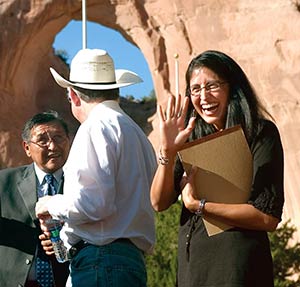A warm welcome
Interior Solicitor Tompkins credits Navajo Nation for her success
By Jason Begay
Navajo Times
WINDOW ROCK, Aug. 27, 2009

(Times photo - Leigh T. Jimmie)
President Joe Shirley Jr. declared Aug. 21 "Hillary Tompkins Day" during a press conference with U.S. Interior Solicitor Hilary Tompkins, her boss, U.S. Interior Secretary Ken Salazar, and Assistant Interior Secretary Larry Echo Hawk.
Hilary Tompkins did not meet another Native American until she was 15.
Before that, her parents, who adopted her from a foster home in Gallup, had told Tompkins that they knew she would eventually go back to the Navajo Reservation.
They probably didn't know that one day her return would mark Hilary C. Tompkins Day on the Navajo Nation.
President Joe Shirley Jr., via presidential order, proclaimed Aug. 20 for Tompkins, solicitor of the U.S. Department of the Interior. Her position, which holds her high in the Barack Obama administration, is the chief general counsel for the Interior, which oversees the BIA.
"My heart is full with a lot of feelings," Tompkins said following the short proclamation ceremony in which Shirley presented her with a Ganado Red Navajo rug.
Tompkins, 41, explained to the crowd of about 30 that she was born in Zuni. Her birth mother "made the difficult decision to give me up at birth," she said.
A few months later, a Quaker family adopted Tompkins and brought her home with them to New Jersey.
"I call it the furthest eastern Navajo agency," she said as the crowd laughed with her.
Tompkins had spent the afternoon on the Navajo Reservation, accompanied by both Interior Secretary Kenneth Salazar and Assistant Secretary for Indian Affairs Larry Echo Hawk.
The team spent several hours with tribal leaders, including presenting at a special meeting of the Intergovernmental Relations Committee and touring the Hunter's Point BIA school and the veteran's cemetery near Fort Defiance.
The U.S. Senate confirmed Tompkins as solicitor in June. Her position as the department's chief general counsel means she represents the department in administrative and judicial litigation as well as meetings, negotiations and other contracts with all governmental entities.
Her work, representing the BIA in several capacities is fitting, considering her extensive work with Native American tribes.
Her parents - Nancy and Kenneth Tompkins - had emphasized her Navajo side growing up, she said.
"They said, 'You'll go back, some day,'" she said.
During her visit, Tompkins addressed the IGR and thanked the tribe for its help in pushing her through college. When she was initially accepted into Dartmouth College, her parents were upset as they couldn't afford the tuition, she said.
She did, however, apply for and was awarded the Navajo Nation's Chief Manuelito Scholarship, a prestigious award that recognizes exceptional undergraduate students.
"Thank you," she told the committee. "I would not have gone to college if not for the Navajo Nation. This is what your support can do."
Tompkins graduated from Dartmouth College's government program in 1990. Then, just as her parent's predicted, she moved to the Navajo Nation.
"I met other Indians at Dartmouth," she said. "After that I felt like I needed to go home."
In the early 1990s, Tompkins worked as a law clerk for the Navajo Nation Supreme Court. She also worked as a tribal court advocate with the Department of Justice.
Tompkins specifically recalled working as a paralegal with Chief Justice Herb Yazzie, who at the time was chief legislative counsel.
Tompkins eventually moved on after she was accepted into the Stanford University Law School where she was associate editor of the Stanford Law Review.
"The people here were instrumental in my decision to go to law school," Tompkins said. "Without them, I would not be where I am today. They encouraged me to keep on my life's path."
Since then, Tompkins has taught as a law school professor at the University of New Mexico in Albuquerque and has served as chief legal counsel under Gov. Bill Richardson.
She has also been reunited with her birth parents, who helped organize her traditional wedding to Michael Prindle in 2000 in Ramah.
During his proclamation, Shirley commended Tompkins for her work, with the tribe, the state, and now with the federal government.
"The Navajo people always encourage their young to work hard, get educated and come back to help their people," Shirley said. "Hilary has done that and gone beyond."
Salazar also commended Tompkins, calling her selection as solicitor as a means to surround the department with "the best of the best."
"She has come a long way," he said. "And this is only the beginning."
But for Tompkins, the long road would have been all but impossible if not for her roots in and continued relationship with the Navajo Nation, she said.
"That's what I feel like to be a Navajo - Diné nishlí - how I view who I am," Tompkins said. "It would be hard to be the first Native American solicitor without knowing what that meant in my heart."

